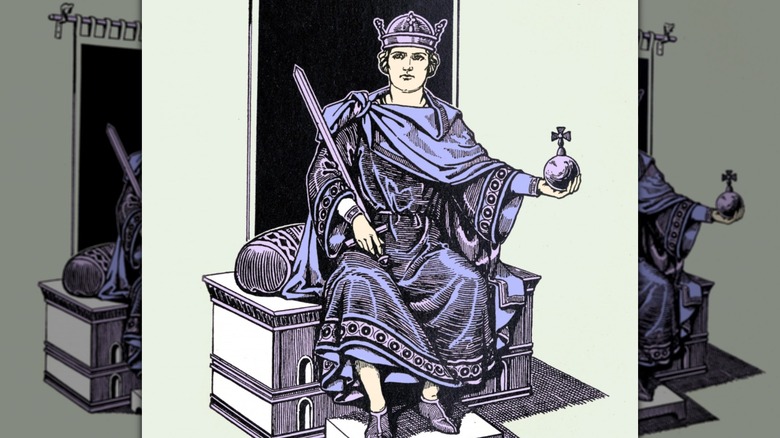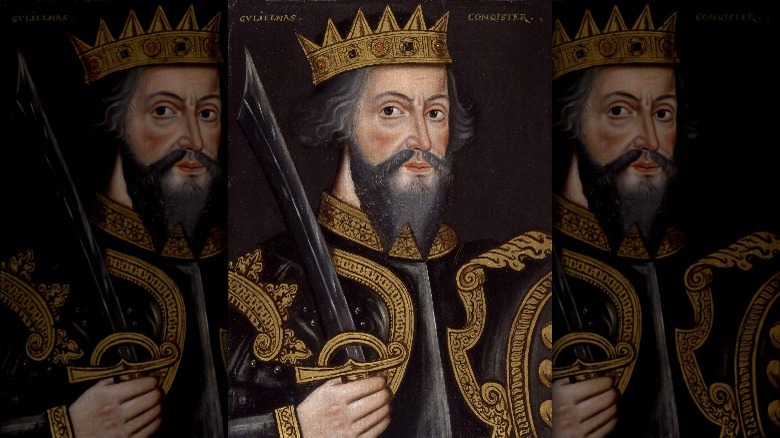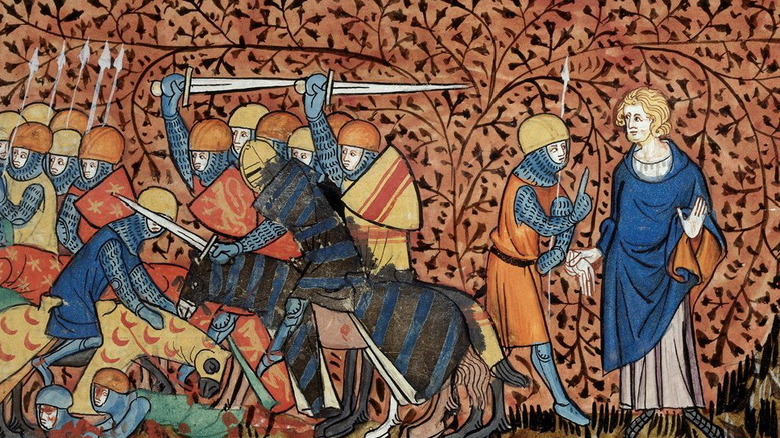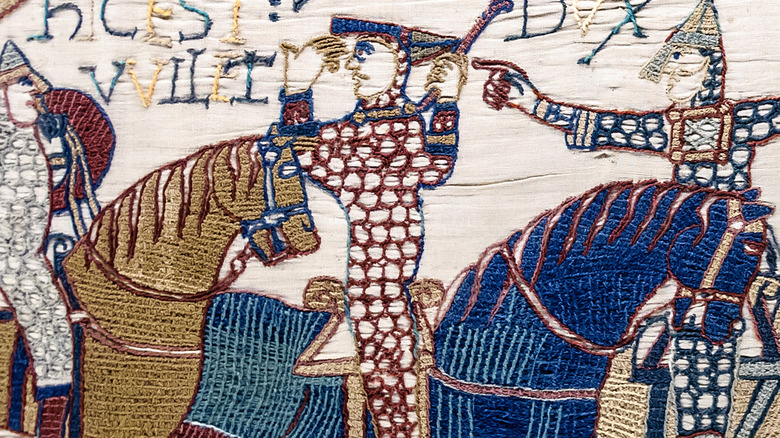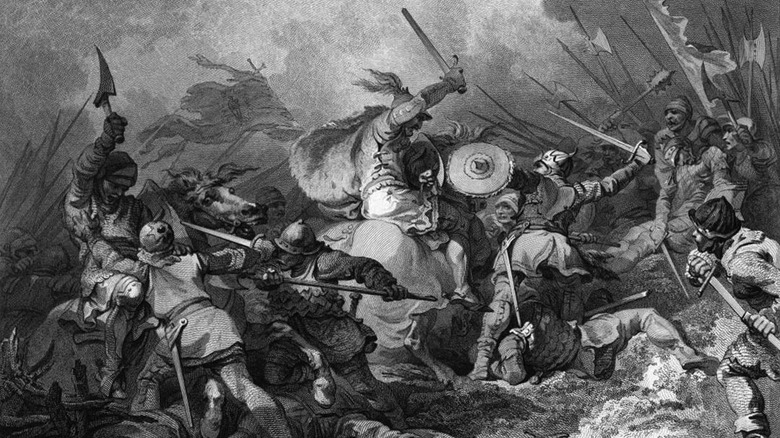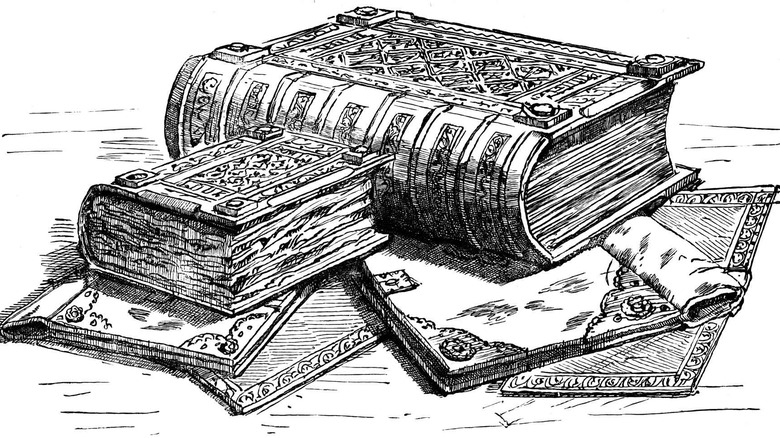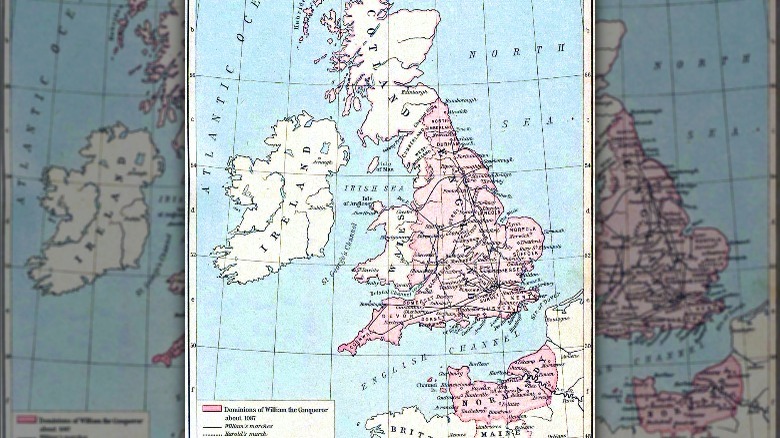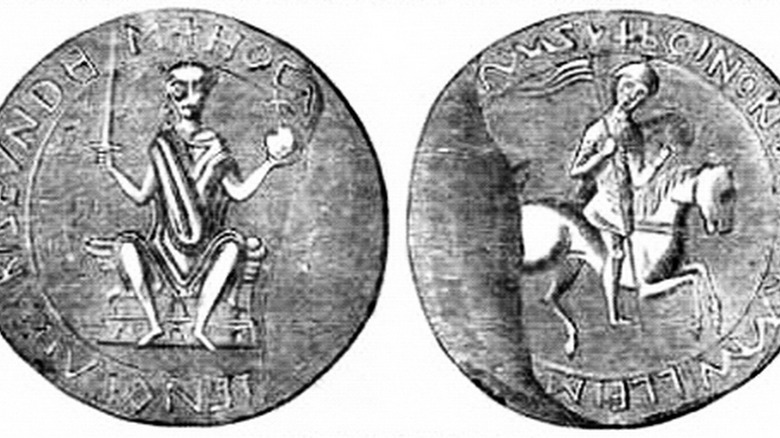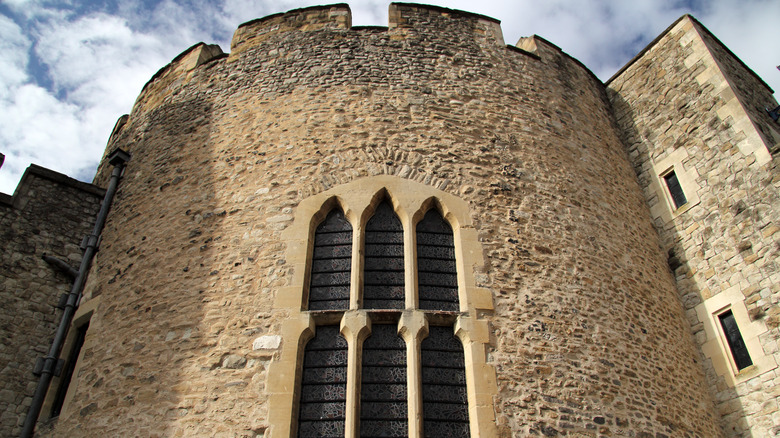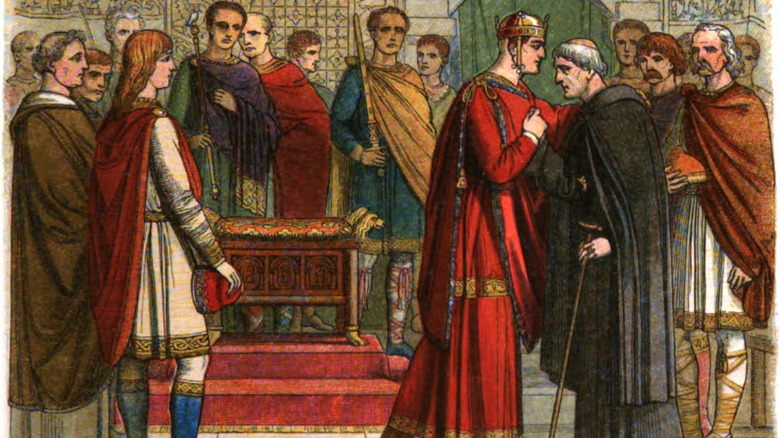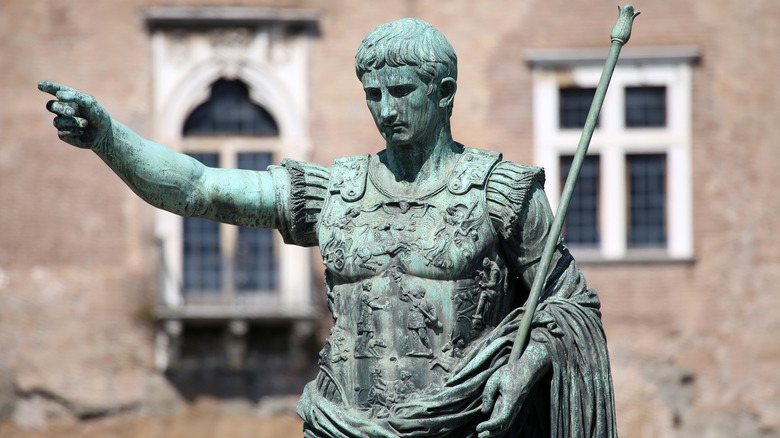You May Not Have Realized How Rich William The Conquerer Actually Was
As William the Conquerer's name can attest to, he was primarily known for one big thing — conquering. He spent practically his whole life conquering before settling into the cushy English throne and promptly revolutionizing many things about the way the English royalty hoarded its wealth. William had another moniker too, though, according to Britannica — "the Bastard." Literally speaking, he was a bastard, but his numerous enemies also tended to see him in a rather negative light.
William came to the throne under peculiar and bloody circumstances. Edward the Confessor, the King of England from 1045-1066, promised the throne to William while William was just a boy in Normandy. However, as Britannica points out, William was not the only guy out there with a claim to the throne, and when Edward died, the throne was usurped by Harold Godwinson, who didn't realize just what an enemy he had made in William. William, then still "the Bastard," had been gradually earning his other nickname and he really solidified it when he rode into England, killed Harold, and took the throne in 1066, kicking off a reign that would stand the test of time.
Turns out he was actually very good at making money as well, making him one of the richest people to have ever lived. Here's a look at just how wealthy he really was.
He was worth between $209-229 billion
Getting an accurate number on a historical figure's net worth is not an easy task. Consult any list of the richest people in history, and you will find a wide array of ways to describe wealth. Money, for instance, compiled a list of 10 of the richest historical figures of all time. The list includes Genghis Khan, Akbar I, Mansa Musa, and more, but actually attributing a number to their wealth is more guesswork than exactitude. Most of it comes down to how much of the world GDP their nation or empire contributed to, and how much of that GDP is attributed to them. For instance, even a more modern name like Joseph Stalin has his complications. He ruled a nation that accounted for 9.6% of the world GDP, according to Money. That's a lot of money. How much? Hard to say, but definitely a lot.
Conveniently for William the Conquerer, however, he kept a detailed record of all tax collection in his Domesday Book, according to Historic UK, and thanks to his meticulous record-keeping, it's a bit easier to assign a number to his net worth that isn't as much of a guess — and that number is in the vicinity of $209-229 billion (via The Richest).
He got started early
While William was still a wee "Bastard" and not yet the conquerer he is known as today, he was more or less thrust into a leadership role and given control over a sprawling kingdom that no child should be lord over. Call it a baptism by fire. His father Robert, Duke of Normandy, was on his way back home when he died in 1035, via Britannica. With just one son, albeit now a bastard, there was no question who would ascend to the vacancy — William, all of 8 years old and not very highly looked upon because of his age and his moniker.
All that said, if you're going to get rich in the middle ages, being a duke of a profitable duchy at the age of 8 is not the worst way to get started. For William, he didn't sink under the pressures heaped upon him. Of course, he also had help. The French King at the time, Henry I, was in William's corner from the start, helping him establish himself as a boy-duke and by all accounts (via Britannica), that help proved monumental, though not infallible. William still suffered from an immense power grab all around him. His tutors and attendants were killed mysteriously, and his support base was pulled out from him. He had to handle far more than any 8 year old should.
Through it all, William hardened himself far younger than he ought to have and came out of it ready to do something with himself and his duchy.
He was already invading as a teenager
It took several years for William to figure out how, as a young boy entering his teenage years, he was going to cope with the private castles and power voids spawning all over his duchy. When he turned 15, he was officially knighted, according to Britannica, and he took it upon himself to fix all the problems that had sprung up in his early years. Problems like rogue barons in their private castles, grubbing at the duchy, eager to seize power themselves. Through those early years from 1046 to 1055, the battles raged, and William counted on French King Henry I to bail him out more than a few times.
After a few crucial battles, Normandy fell in line and William began to look outwards at Brittany, Maine, Anjou, and other French territories. He negotiated and fought his way into greater stability, adding to the French and Norman holdings and establishing himself as a vetted ruler while still in his young age. He connected with Edward the Confessor, his cousin and the King of England, and proved so capable that he was named heir to the throne.
By now, the stage was set for some serious wealth accumulation for William. He had a bigger duchy than before, and he had friends and cousins on the thrones of two of the biggest kingdoms in the middle ages. And that was not to mention being the heir to the English throne himself.
When it came time to invade England, fortune smiled on him
Of course, nothing ever goes according to plan, not even for William, who had already had to fight through so much that didn't go according to plan. When Edward the Confessor, King of England, died in 1066, William was meant to ascend to the throne, but Harold Godwinson went full scoundrel and usurped the throne before William could take it, according to Britannica. If Harold had been paying attention, he would have seen that this wasn't the best idea. William had handled French rivals as a teenager, and now he was coming for the English throne as an adult.
Military might alone may well have culled the throne for William, but he also found himself on the good side of luck this time. Harold had been engaged with the Norwegian invasion in the North, and the Anglo-Saxon army was being pushed and pulled north and south, wearing themselves out. By time William arrived, via History, they were beleaguered, and William cut through them all the way to the throne, killing Harold in the process, taking numerous land holdings, and securing the English countryside.
It was a comprehensive victory, and it set William up like never before. He was king now, and the wealth started to pour in from four different sources.
The first source of wealth was taxes
One of the biggest and long-lasting impressions William made on not just England, but the world as a whole, was his new and innovative form of taxation. Needing money to pay for his armies to keep unrest at bay, William ordered a complete survey of the English islands in 1085 to get a sense of how much each and every settlement had, and how much they would therefore be capable of paying in taxes. The complete compilation was called the Domesday Book, via History UK, and it contained accounts of 13,418 unique settlements and their assets.
What makes William's form of taxation so unique, though, is that it was completely fair, according to The Richest. He required taxes proportional to what people owned, therefore everybody paid their fair share to the English crown, no one was crushed by taxes, and the richer paid more than the poor. Which seems like such a novel concept, especially at the time.
The sheer level of organization required to oversee this massive undertaking is astounding. It looks more like a modern form of taxation, minus the fact that people were paying taxes in pigs and herrings.
The second source was land
When William the Conquerer invaded England to take the throne, he didn't just go straight to the throne. He also took practically all of the land holdings formerly owned by Harold Godwinson, the usurper. All of that land was added to the growing fortunes of William. More than that though, after being crowned king, William claimed all the land in England for himself, according to Spartacus Educational. Once he acquired it all, he divvied it out as he saw fit, keeping 20% of the land for himself, giving 25% to the church, and parsing the rest out to all of his friends and allies who had helped him take the throne. They all had to swear loyalty to the King individually once he gave them their land.
Personally owning 20% of the land and having allies that own another 55% is only naturally going to provide a stream of revenue. All that land contributed to the compilation of the Domesday Book, his great big tome of taxation, via History UK, and thus it further padded his growing fortunes.
That doesn't account for his landholdings back in France, too. He was still ruler over Normandy, and through handling of rebellions in Maine and elsewhere, according to Spartacus Educational, he continued to protect the land that was making him filthy rich.
The third source was treasure
William took a great deal of land when he invaded England from Normandy, and one of the great things about owning plots of land is that you also technically own whatever is underneath that land as well. For William, what he found buried underneath a lot of the land he declared as his own was copious amounts of treasure. According to The Richest, that included all kinds of buried coins and religious artifacts — the kinds of things that farmers loyal to Harold buried for what they hoped would be safekeeping. As they lost their land to William, they also lost the treasure within that land to him.
As far as how much this contributed to his fortune, William unfortunately did not keep a rolling tally — no treasure equivalent of the Domesday Book. That said, as recently as 2019, Anglo-Saxon treasure was still being found buried on unsuspecting plots of land, according to Artnet. This most recent discovery of Anglo-Saxon and Norman coins is even rarer than most because it has coins with Harold Godwinson emblazoned on them, and seeing as how his reign was short-lived, the presence of his face indicates when it was buried and who would have had rights to it — William. Unfortunately for William, he could have been worth even more if he would have done a bit more digging.
The fourth source was construction
It may sound odd that doing construction accumulated wealth, but it was what he constructed that made all the difference — castles, lots and lots of castles, according to History Hit. And with those castles, William was able to protect the wealth and ensure that it came in regularly. He used those castles to oversee his kingdom, all the tracts of land he had acquired, and the people that were paying him.
The grand total of castles tickles the thousands. He constructed 700 motte and bailey castles alone, according to History Hit, all situated in positions of power to ensure that no one could upset William's power or his source of wealth.
Counts among the gobs of structures is the white tower of the now famous Tower of London compound, according to Historic Royal Places. While it took two decades to build, it formed the backbone of what would become a seat of power, a palace, and perhaps the most famous prison in the world. All funded by the richest of rich English kings — William the Conquerer.
He wasn't alone in this wealth
For as rich as William the Conquerer was, it's not like he was hoarding his wealth and keeping it to himself. After all, that wouldn't exactly have been a successful method of garnering more wealth. He had to reward his companions, and that was something he never had trouble doing. In fact, two of the richest historical figures of all time count themselves as relatives and supporters of William throughout his invasion of England.
The first of the rich ones was Alan Rufus, who has an inflation-adjusted net worth of $180 billion dollars, just $40 billion or so shy of William himself, according to Celebrity Net Worth. In his heyday, Rufus was one of the richest men in England.
Right alongside Rufus was William de Warenne, another close companion of William who fought alongside him through various rebellions and battles. De Warenne accumulated a net worth just behind Rufus at $147 billion, according to Celebrity Net Worth. And per Royal Historical Society Fellow Sharon Bennett Connolly, de Warrene's wealth stemmed from land gifts from William the Conquerer, who always saw fit to reward his friends.
How his wealth compares to modern-day financial titans
Given the magic of adjusting for inflation, the modern-day value of William can be ascertained quite clearly at around $220 billion (via The Richest), which is an obscene amount of money. So obscene, in fact, that only one person in the modern echelon of billionaires can hold a candle to William, and that one person is Elon Musk, whose net worth, as calculated by Forbes, is $220.5 billion, putting him just a skosh ahead of our dear Norman conquerer.
After Musk, though, the competition falls by the wayside. Bernard Arnault and his family rank in around $157 million and Jeff Bezos of Amazon fame is just behind that at $141 billion. Subtract a few more billion and Bill Gates shows up at around $126 billion, then Warren Buffet at $109 billion, and off the list falls, further and further away from the slick $220 billion that William the Conquerer is worth.
How his wealth compares to historical financial titans
While it's fairly easy to calculate modern wealth among people who are still living or recently dead, it's harder when you start pulling in historical rulers, warlords, and tycoons who operated so long ago that currency was made of something else entirely. Suffice to say that William, while ranking among the upper echelon of historical bigwigs, doesn't rank at the top of the pile. The top of the pile is populated by the likes of Mansa Musa, according to Money. While it's hard to put an actual dollar sign on what he was worth, given that he ruled the African kingdom of Mali way back in the 14th century, Celebrity Net Worth puts him at around $400 billion. Money, however, makes their own — likely more accurate — estimation of Musa being "richer than anyone could describe."
Then there is Augustus Caesar, who needs a bit of math to account for the ridiculous value placed on his wealth. Given that the Roman Empire at the height in which Augustus ruled accounted for up to 30% of the GDP of the world, and Augustus himself commandeering upwards of 20% of that all on his own, according to Stanford history professor Ian Morris (via Money), that puts Augustus's value at $4.6 trillion. However, like Mansa Musa, so much of historical wealth is a guesstimate without any proper records. The same goes with Genghis Khan, King Solomon, and the like.
After all, not everyone was as meticulous as William and his Domesday Book.
